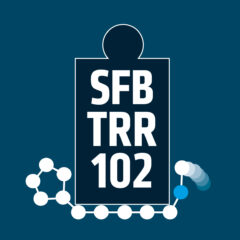“Modulation of amyloid peptides aggregation by hydrophilic polymers” – rehearsal by Zhanna Evgrafova
Location: MLUconf
Time: 15.20 – 17.00
Modulation of amyloid peptides aggregation by hydrophilic polymers
Zhanna Evgrafova
A spontaneous self-assembly process which a particular type of peptides and proteins are subject to, commonly termed as amyloids or amyloidogenic peptides/proteins, can lead to development of incurable neurodegenerative diseases known as Alzheimer’s, Parkinson’s, or Huntington’s diseases. The presence of small molecules, peptides and proteins, nanoparticles, lipid membranes or synthetic polymers strongly affects fibrillation of amyloids in vitro. In contribution to this topic, fibrillogenesis of the irreversibly aggregating amyloid-β 1–40 peptide (Aβ1–40) here is investigated in a physical mixture or in covalent conjugation with hydrophilic thermoresponsive poly(oligo(ethylene glycol)m acrylates). Different molecular parameters of the polymers such as molecular weight, polydispersity index (PDI), cloud point temperature (Tcp), and hydrophilicity are expected to affect on the fibrillation process. The designed polymers are synthesized via RAFT-polymerization technique allowing us to prepare a series of polymers with different molecular masses (Mn = 700 to 14 600 g/mol, PDI = 1.10 to 1.25) and adjustable Tcp. The polymer’s hydrophilicity is altered by variation of the number of ethylene glycol-units in the side chain (m = 1–9), nature of the end group (B = butoxy; C = carboxy; D = dodecyl; P = pyridyldisulfide) and the degree of polymerization (n) of the polymers. The appropriate combination of hydrophobic end groups with hydrophilic side chains controls overall polymer’s hydrophilicity and thus the polymer’s Tcp, what in turn influences fibrillation pathways of the Aβ1–40 admixed with the polymers.
Polymer-peptide conjugates comprising the Aβ1–40 peptide and the poly(oligo(ethylene glycol)m acrylates) (m=2, 3) (Mn up to 6000 g/mol) are successfully synthesized via two different coupling techniques. The obtained conjugates exhibit no detectable Tcp up to 90 oC.
The aggregation behavior of the polymer-Aβ1–40 conjugates is investigated via ThT detected fluorescence measurements. It is observed that the conjugates with the highest molecular weights aggregate faster than the analogues with the lower molecular weights or the Aβ1–40 alone. The final morphology of the obtained aggregates is significantly different from the conventional amyloid fibrils. Instead of long and straight fibrils, bundles of short aggregated are detected.




